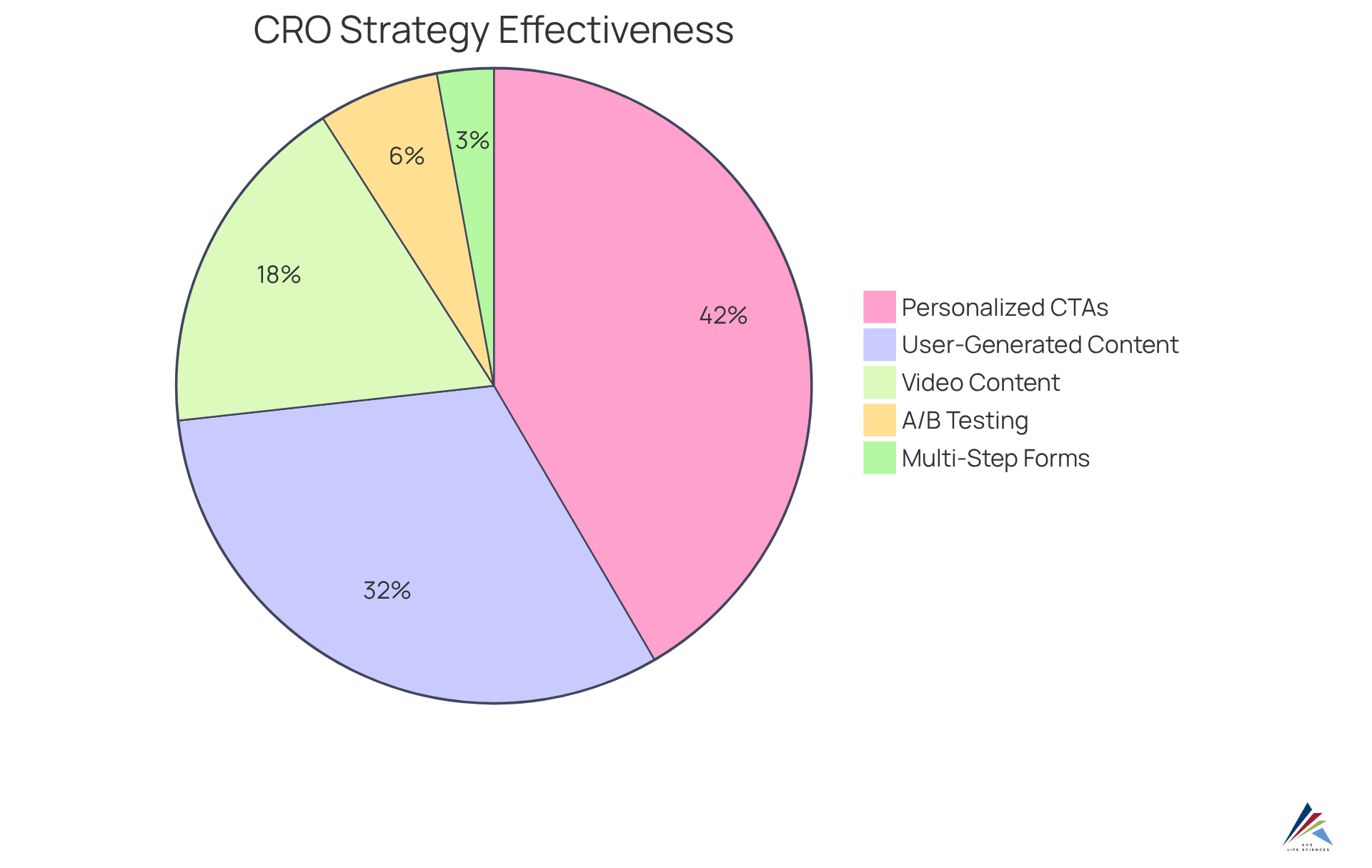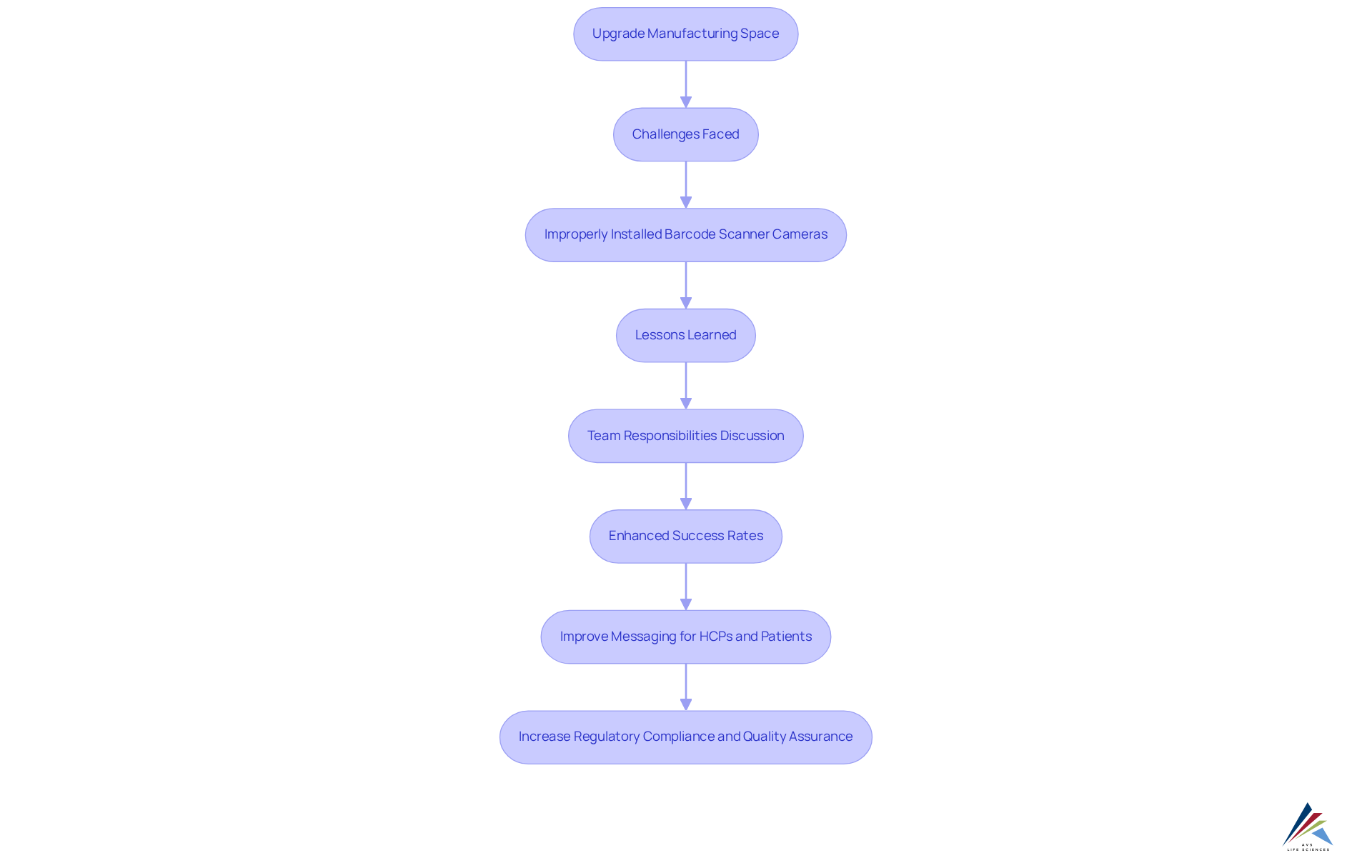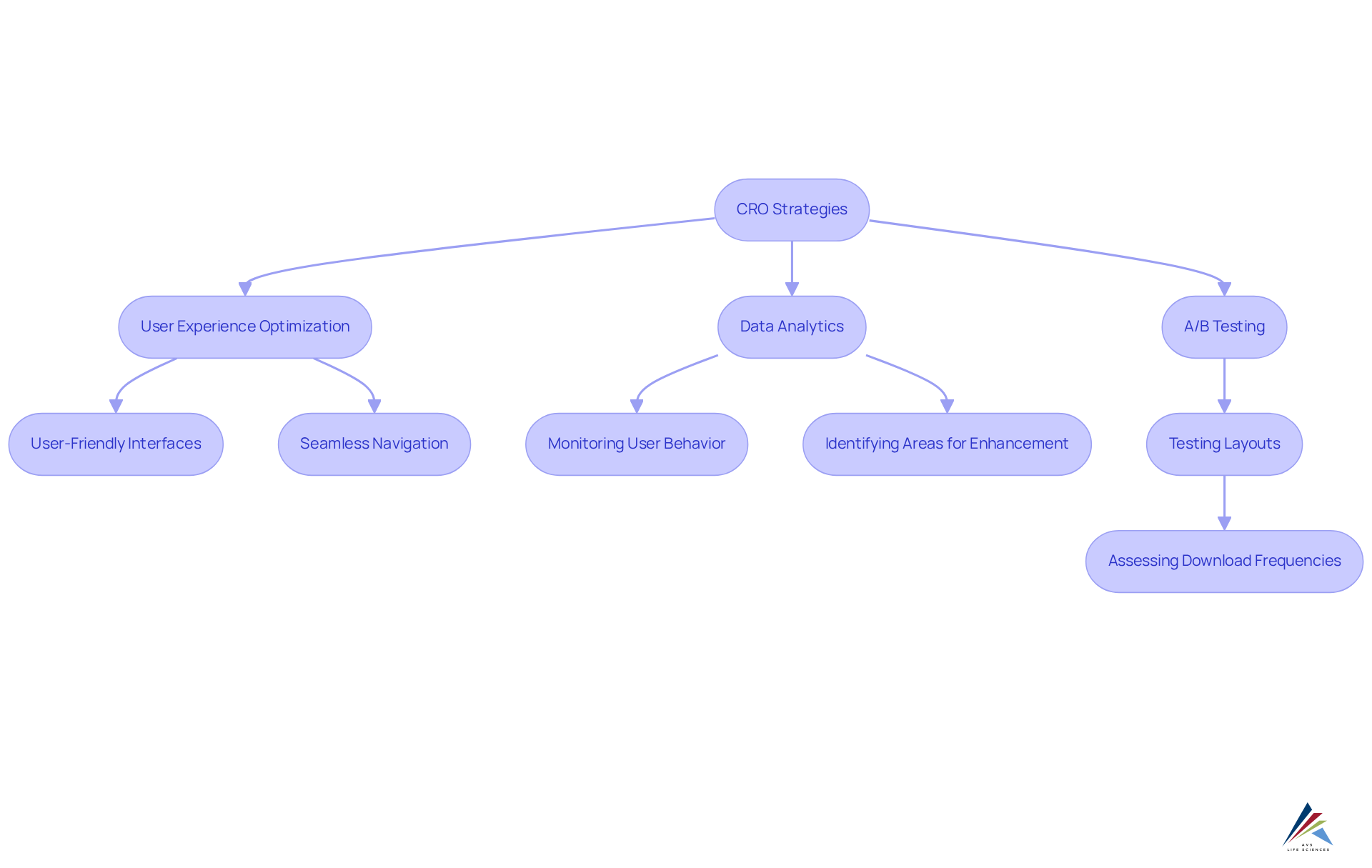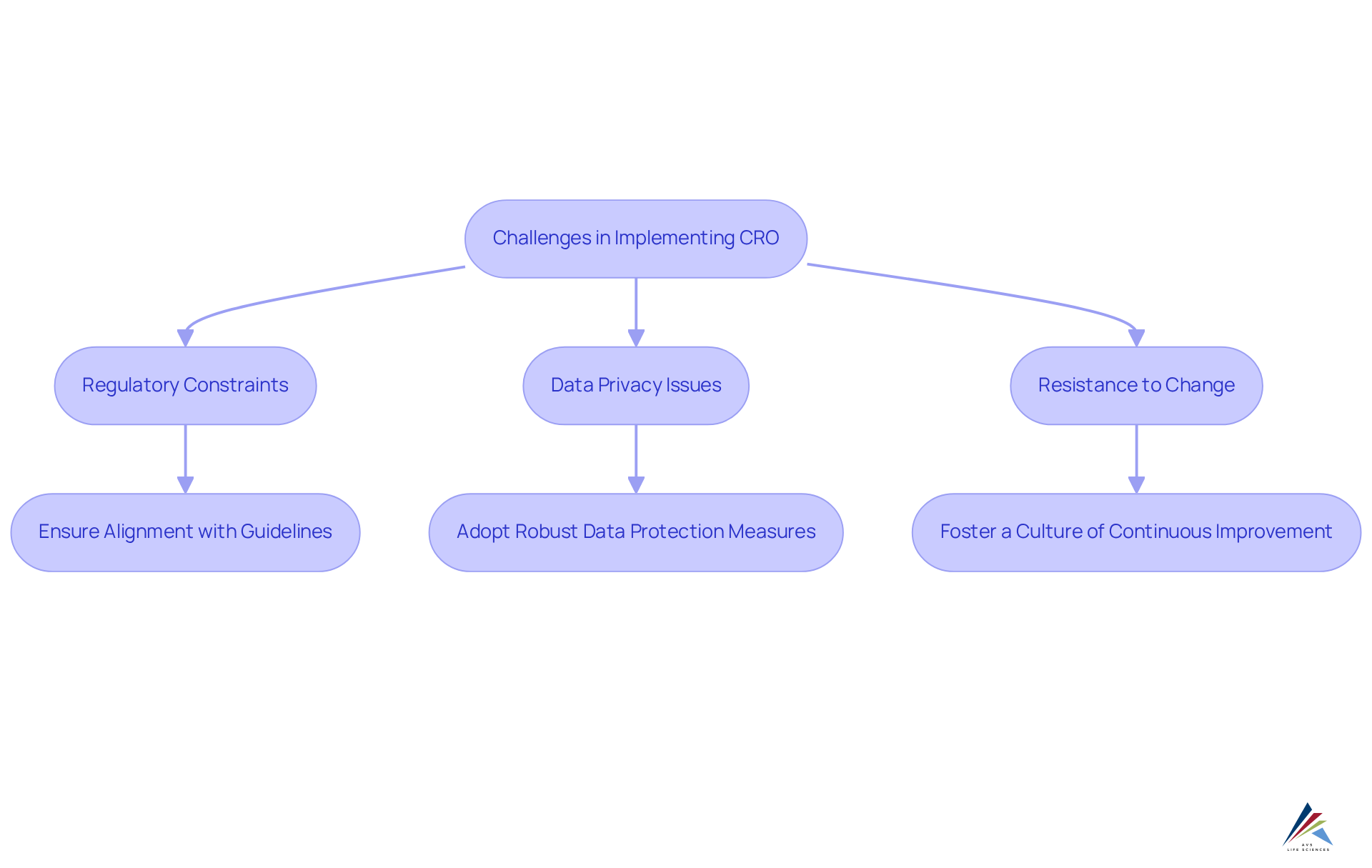CRO Meaning: Essential Insights for Pharmaceutical Compliance Officers

Overview
The article elucidates that Conversion Rate Optimization (CRO) is essential for pharmaceutical compliance officers, as it significantly enhances user engagement and ensures adherence to regulatory standards in marketing practices. Evidence supports this assertion, demonstrating that effective CRO strategies—such as personalized content and user behavior analysis—substantially improve communication with healthcare professionals and patients. This, in turn, leads to enhanced compliance and improved patient outcomes. By addressing compliance challenges head-on, CRO not only fosters better relationships with stakeholders but also drives a commitment to regulatory excellence.
Introduction
Understanding the intricacies of Conversion Rate Optimization (CRO) is vital for pharmaceutical compliance officers navigating the complex landscape of healthcare marketing. As the industry strives to enhance user engagement and improve patient outcomes, the significance of CRO becomes increasingly apparent.
However, with 82% of marketers identifying challenges in implementing effective CRO strategies, compliance officers must consider how to leverage these practices not only to meet regulatory standards but also to drive meaningful interactions.
This article delves into the essential insights of CRO within the pharmaceutical context, exploring its impact on compliance, quality assurance, and overall marketing success.
Define CRO: Understanding Conversion Rate Optimization in the Pharmaceutical Context
The term CRO meaning, which stands for Conversion Rate Optimization, represents a systematic process aimed at increasing the percentage of users who take desired actions on a website or application. Within the pharmaceutical context, this may involve prompting healthcare professionals (HCPs) or patients to engage with content, subscribe to newsletters, or request additional information about a product. The primary objective is to enhance user experience and cultivate significant interactions that ultimately lead to improved patient outcomes and heightened adherence to regulatory standards. For compliance officers, grasping the CRO meaning is essential, as it directly influences the effectiveness of pharmaceutical companies in communicating their value propositions to target audiences.
Effective CRO practices can significantly enhance marketing efforts. Personalized call-to-action buttons, for instance, have been shown to achieve success levels that are 202% superior to standard options, while personalized CTAs attract 42% more visitors than their generic counterparts. Moreover, incorporating user-generated content can increase sales by 154%, and interaction with UGC doubles the likelihood of making a purchase, enhancing success metrics by 102%. This underscores the critical role of trust and involvement in healthcare marketing.
In healthcare, effective examples of CRO include the use of video content on landing pages, which can elevate success rates by up to 86%. The integration of a video into a landing page can boost success metrics by 80%, highlighting the powerful impact of video content on performance. As the healthcare landscape evolves, understanding CRO meaning and adopting its strategies will be vital for pharmaceutical firms aiming to improve their marketing efficiency and comply with industry regulations. However, it is noteworthy that 82% of marketers find CRO challenging, indicating that while opportunities for improvement exist, substantial hurdles remain. The average conversion rate in healthcare stands at 3%, serving as a benchmark for evaluating the effectiveness of CRO strategies within this sector.

Explore the Importance of CRO for Pharmaceutical Compliance and Quality Assurance
CRO plays a crucial role in pharmaceutical regulations and quality assurance, ensuring that marketing and communication strategies are not only effective but also conform to regulatory standards. A prime example of this is AVS Life Sciences' recent project, where they assisted a leading biotechnology company in upgrading their manufacturing space from a Biosafety Level 1 GMP facility to a Level 2 GMP facility. This upgrade was completed on time and within budget, showcasing AVS's dedication to quality assurance and regulatory adherence.
Challenges arose during the upgrade, including anomalies in test results due to improperly installed barcode scanner cameras, which were initially overlooked. This experience led to important lessons learned and discussions about team responsibilities and workload.
By enhancing success rates, organizations can develop messaging that connects with healthcare professionals (HCPs) and patients, promoting informed decision-making in an industry where misinformation can result in significant repercussions. A strong strategy that embodies CRO meaning allows companies to observe user interactions, producing valuable data that can improve regulatory frameworks and enhance quality assurance processes.
Moreover, examining user behavior on a clinical trial registration page enables organizations to identify obstacles to engagement and tackle them efficiently, thus enhancing both compliance and user experience. This approach not only fosters adherence to regulatory requirements but also contributes to the overall integrity of the pharmaceutical development process.

Identify Key Components of CRO: Strategies and Best Practices for Compliance Officers
An effective Conversion Rate Optimization (CRO) strategy in the pharmaceutical sector, which reflects the CRO meaning, is fundamentally anchored in user experience optimization, data analytics, and A/B testing. Compliance officers must prioritize the creation of user-friendly interfaces that enable seamless navigation and straightforward access to vital information.
By leveraging data analytics, organizations can monitor user behavior, identify areas requiring enhancement, and make informed decisions to elevate overall performance. For instance, a pharmaceutical firm might conduct A/B testing on two distinct layouts for a product information page to ascertain which design yields a higher download frequency for patient information leaflets.
Such strategies not only bolster success metrics but also ensure compliance with regulatory standards by delivering clear and accessible information. Remarkably, landing pages optimized for user experience can experience conversion rate increases of up to 220%, illustrating the CRO meaning and the critical importance of these practices within the pharmaceutical industry.

Address Challenges in Implementing CRO: Solutions for Compliance Officers
Implementing strategies related to CRO meaning presents significant challenges for regulatory officers, particularly regarding regulatory constraints, data privacy issues, and organizational resistance to change. To navigate these hurdles, regulatory officers must ensure that all CRO initiatives align with the CRO meaning and comply with guidelines established by authorities such as the FDA and EMA. This alignment is crucial for maintaining regulations and avoiding potential penalties.
Furthermore, organizations should prioritize data privacy by adopting robust data protection measures that align with regulations like GDPR. Such actions not only safeguard sensitive information but also cultivate trust with stakeholders and patients alike.
To address resistance to change, regulatory officers can foster a culture of continuous improvement within their organizations. By providing comprehensive training and resources that clearly articulate the benefits of CRO meaning, such as enhanced patient engagement and improved compliance, regulatory officers can secure buy-in from key stakeholders. For instance, showcasing case studies where CRO strategies have successfully improved operational efficiency can further illustrate the value of these initiatives.
By proactively tackling these challenges, compliance officers can effectively implement CRO strategies that not only enhance compliance but also drive overall business performance.

Conclusion
Understanding the significance of Conversion Rate Optimization (CRO) is crucial for pharmaceutical compliance officers who seek to enhance their organizations' marketing effectiveness while adhering to regulatory standards. This strategic approach not only elevates user engagement but also promotes improved patient outcomes and compliance with industry guidelines.
The article delineates the importance of CRO within the pharmaceutical sector, underscoring its role in optimizing user experience, leveraging data analytics, and ensuring compliance with regulatory frameworks. Key insights reveal the substantial impact of personalized content and video integration on conversion rates, alongside the necessity of addressing challenges such as regulatory constraints and data privacy concerns. By implementing effective CRO strategies, organizations can markedly enhance their success metrics while upholding quality assurance processes.
Ultimately, the adoption of CRO practices is imperative for pharmaceutical companies striving to navigate the complexities of compliance while refining their marketing initiatives. By prioritizing user experience and harnessing data-driven insights, compliance officers can not only bolster their organizations' performance but also contribute to a more informed and engaged healthcare community. A steadfast commitment to understanding and executing CRO strategies will facilitate a more effective communication of value propositions, fostering trust and engagement in an industry where accuracy and reliability are paramount.
Frequently Asked Questions
What does CRO stand for and what is its purpose?
CRO stands for Conversion Rate Optimization, which is a systematic process aimed at increasing the percentage of users who take desired actions on a website or application.
How is CRO applied in the pharmaceutical context?
In the pharmaceutical context, CRO involves prompting healthcare professionals (HCPs) or patients to engage with content, subscribe to newsletters, or request additional information about a product, with the goal of enhancing user experience and improving patient outcomes.
Why is understanding CRO important for compliance officers in the pharmaceutical industry?
Understanding CRO is essential for compliance officers because it directly influences the effectiveness of pharmaceutical companies in communicating their value propositions to target audiences while adhering to regulatory standards.
What are some effective practices in CRO for enhancing marketing efforts?
Effective CRO practices include using personalized call-to-action buttons, which can achieve success levels 202% higher than standard options, and personalized CTAs that attract 42% more visitors than generic ones.
How does user-generated content (UGC) impact sales in healthcare marketing?
Incorporating user-generated content can increase sales by 154%, and interaction with UGC doubles the likelihood of making a purchase, enhancing success metrics by 102%.
What role does video content play in CRO within healthcare?
Video content on landing pages can elevate success rates by up to 86%, and integrating a video into a landing page can boost success metrics by 80%, demonstrating its powerful impact on performance.
What challenges do marketers face regarding CRO in the healthcare sector?
Despite the opportunities for improvement, 82% of marketers find CRO challenging, indicating that substantial hurdles remain in optimizing conversion rates.
What is the average conversion rate in the healthcare industry?
The average conversion rate in healthcare is 3%, which serves as a benchmark for evaluating the effectiveness of CRO strategies within this sector.
